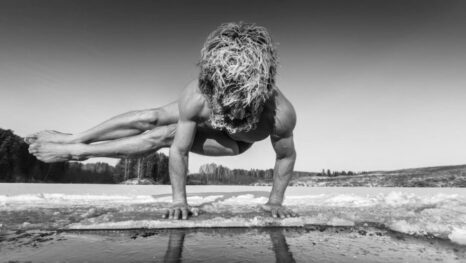Wim Hof Method – The Iceman Cometh
Wim Hof is known as the iceman – a long-time proponent of ice baths, swimming in freezing water and forcibly lowering the body temperature to set in motion a chain if wellbeing benefits.
 The Dutch extreme athlete is known not just for embracing hardcore freezing activities, but for no-less-hardcore breathing techniques, which involve a sort of meditative combination of suffocation and hyperventilation.
The Dutch extreme athlete is known not just for embracing hardcore freezing activities, but for no-less-hardcore breathing techniques, which involve a sort of meditative combination of suffocation and hyperventilation.
Both exposure to cold and breathing techniques are well known to improve everything from mental health to biomechanics and from metabolism to immunity.
In our earlier article about cryotherapy, we examined the science behind cold therapy – with evidence pointing to the multiple benefits of bringing the body into a lower-than- comfortable temperature. Proponents and research both indicate that getting freezing cold on purpose, on a regular basis can help reduce inflammation (great for arthritis symptoms), boost energy, stimulate the immune system and galvanise all number of hormonal processes for better metabolism and improved state of mind.
Combining cold water therapy with breathing techniques is key to Wim Hof’s theory, although each of these can be used to positive effect on their own.
Simon Moyes likes to start the day with a 10-minute Wim Hof breathing cycle, followed by a cold shower – which has an immediate feel-good factor, but it’s also been claimed to have longer-term positive impacts.
The breathing techniques – involving a combination of breath-holds, deep breathing and rapid panting – are intended to push out a maximum of carbon dioxide and draw more oxygen into the body.
A 2019 study shows that these type of breathing techniques can have a positive effect in reducing the effects of axial spondyloarthritis – which has implications for treating other arthritic and chronic inflammatory conditions. However, this study only had 31 participants, and researchers stated that their results should serve as a starting point for more research.
Many athletes use the Wim Hof technique as a method of enhancing their performance, although studies to prove the efficacy of this are scarce. This study of 15 athletes showed no difference at all in power and fatigue in sprinters.
While numerous studies have demonstrated the immediate reduction of CO2 in the body and increased alkalinity of the blood during the Wim Hof breathing cycles, there is as yet no evidence that this has any long-term impact after the breathing returns to normal.
There is also no evidence as yet that the Wim Hof method (cold exposure and breathing combined) increases brown adipose tissue (BAT) in the body, however there is research showing that regular exposure to low temperatures leads to an increase in BAT in mice.
A recent article in Nature also points to recent research indicating that tumour growth can also be slowed by regular exposure to cold temperatures in mice.
The inflammatory response of the body may be influenced by Wim Hof breathing techniques, meditation and cold exposure, according to this study in 2014. The study group consisted of 9 healthy participants, with 6 in the control group, so the results would need to be supported with larger studies before they can be accepted as mainstream evidence for the efficacy of the method.
There was also no control to analyse whether inflammatory responses reduced as a result of one, two or all three training methods in combination.
The researchers point out that there no evidence showing that the Wim Hof method is effective in reducing inflammation in patients with chronic autoimmune disease.
While research into the Wim Hof method is yet to provide conclusive evidence of its efficacy, its proponents are in no doubt about its positive impact on their wellbeing, physical resilience and improved mobility.
More studies are needed to prove conclusively one way or another, but the multitude of studies on the positive effects of cold water therapy, meditation and breathing techniques – which have been used by humans for millennia – are regarded as evidence enough for those who engage in Wim Hof’s system.
As with so many wellbeing-enhancing programmes – a holistic approach includes an understanding that the ‘placebo effect’ can be as potent to improving your mental and physical health as any scientifically proven concept.
